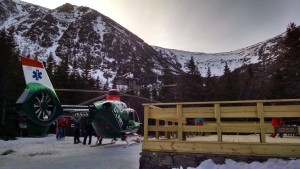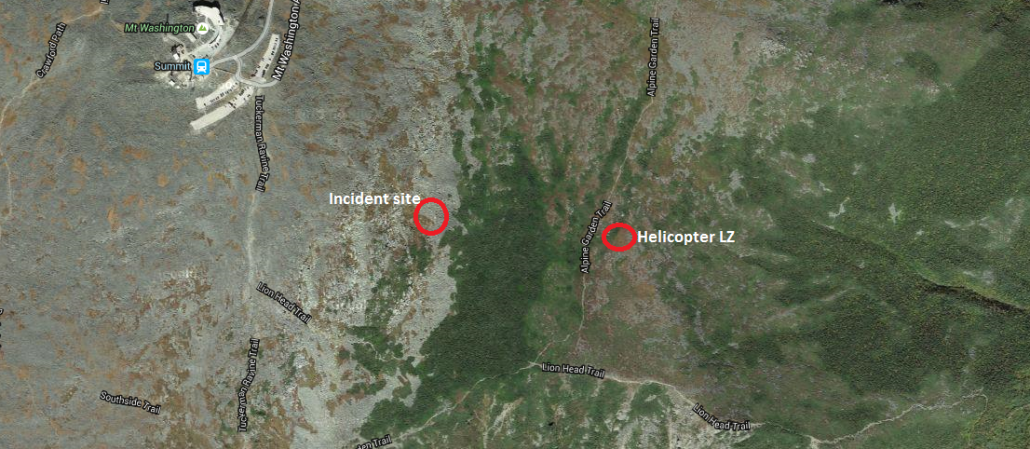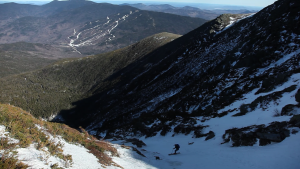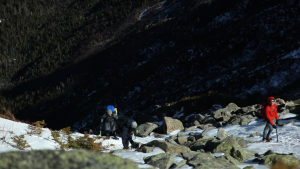On Sunday afternoon, March 13, two separate accidents occurred on the east side of Mount Washington. Both accidents involved long sliding falls and resulted in life-threatening injuries. Luckily, the skies were clear and the wind was calm, allowing both patients to be evacuated via helicopter. There are several lessons to take away from these incidents, all coming back to the basics of being prepared and making safe travel decisions.
The first accident occurred when a skier slipped and fell in Hillman’s Highway. Hitting several rocks on the way down, he sustained serious injuries requiring immediate evacuation. Just as the helicopter departed Hermit Lake, the second call came in of an injured hiker on the summit cone. Again, due to a serious injury and a lengthy carry-out, USFS Snow Rangers decided to use a helicopter for transport. A large thank you must be given to all rescuers involved including the Mount Washington Volunteer Ski Patrol, AMC, Mount Rescue Service, AVSAR, NH Fish and Game, and several volunteers as the evacuations went smoothly and patients arrived at advanced care in a timely manner.
Weather and Snowpack Analysis
The week leading up to these two incidents coincided with the transition from winter to spring in Tuckerman and Huntington Ravine. On Tuesday, March 8 at 10pm, the temperature on the summit rose and remained above freezing for 48 hours. During this time period, the summit recorded over 1.25” of rain. After the warm up, temperatures dropped over 24 hours to the low teens, allowing the water-saturated snowpack to freeze solid. On Saturday, temperatures warmed along with clear skies, allowing the snow to soften and turn to corn in many areas. Skiers reported excellent spring conditions in The Lip, Right Gully, and the East Snowfields on the summit. Left Gully and Hillman’s Highway had parts that softened, while parts remained frozen solid. Saturday was followed by a blustery, clear day on Sunday. Skiers reported certain areas softening up, however not to the degree as the day before. Sunday was the type of day where as soon as snow had shadows cast upon it, the surface froze instantly into firm concrete.
Incident #1: Skier Fall in Hillman’s Highway
Around 3:20pm, six experienced skiers began to descend Hillman’s Highway. One of the skiers slipped and fell approximately 1,000 feet. Upon arrival at the scene, USFS Snow Rangers and members of the Mount Washington Volunteer Ski Patrol determined the patient had sustained multiple life-threatening injuries. After a lower down the remainder of Hillman’s Highway and transport to the awaiting helicopter at Hermit Lake, the patient was in the air and on his way to advanced medical care at 5:14pm.
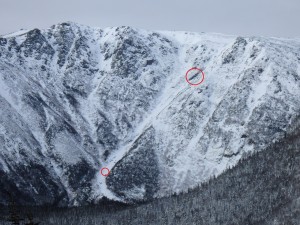
Hillman’s Highway a week prior to the incident. The two red circles indicate where the skier fell and where he came to a rest.
The party of six initially started as multiple parties. The group that the patient was a part of toured into the Gulf of Slides and experienced decent corn conditions in Gully #1. After the descent, the group decided to climb up and over Boott Spur and ski the looker’s right fork of Hillman’s Highway. Standing at the top of Hillman’s Highway, the group, now joined by three other skiers, recognized the snow had changed dramatically from their previous run. Two skiers, including the soon to be patient, donned crampons and an ice axe and climbed down about 200 feet to better assess and avoid the ice at the rollover. Recognizing the hazard, members of the group collectively decided the risk was manageable with conservative skiing techniques. The first skier made his way to the bottom of the choke and pulled aside to allow the second skier to go. This second skier lost his edge on a patch of ice in the narrows. As the snow had gone into the shade and turned to concrete, the skier had no chance to self-arrest and began an out-of-control slide down Hillman’s Highway. Due to the low snowpack this winter, Hillman’s Highway, normally a good choice for novice Tuckerman skiers, was full of ice bulges and rock outcroppings.
Falling about 1,000 feet, he came to rest just above the dogleg near the bottom of Hillman’s Highway. The rest of the group made their way to him as quick as the conditions would allow. Upon arrival, they prevented him from sliding further down the slope and immediately for help. Snow Rangers, along with Mount Washington Volunteer Ski Patrol members arrived at the patient about 30 minutes after his fall. The initial assessment indicated life threatening injuries. Oxygen was administered, the decision to transport via helicopter was made, and the patient was strapped into a litter for travel to the awaiting helicopter at Hermit Lake.
Incident #2: Hiker Fall near South East Snowfields
At 5:16pm on Sunday evening, the Gorham Police Department received a call from hikers in distress on the summit cone of Mount Washington. There was confusion as to the exact location of the hikers, but they told Snow Rangers via cell phone that one member of their group of three had broken his femur during a glissade that turned into an out-of-control slide, and was now getting very cold. A hasty team of one Snow Ranger and the AMC caretaker departed Hermit Lake at 5:45pm, ascending the Lion Head summer trail. With weather still clear and calm, and dealing again with a possible life-threatening injury, Snow Rangers again decided the best evacuation option was with a helicopter. The hasty team made visual contact with the hikers just before reaching the Alpine Garden/ Lion Head Junction. At 7:07pm, the helicopter landed .25 miles away from the patient. Snow Rangers quickly realized that due to difficult terrain, it was unfeasible to drag the patient to the LZ without a litter. As the helicopter had to return to base at 8pm due to flight regulations, it left the scene at 7:40pm without the patient.
Over the next hour, more rescuers and a litter arrived. Upon further discussion with dispatch, a new crew boarded the helicopter and took flight, aiming for the landing zone established east of the Alpine Garden Trail. This helicopter landed at 9:14pm, 10 minutes after the rescuers and patient arrived. The helicopter departed with the patient at 9:26pm and rescuers made their way to the snowcat at the Cow Pasture and descended the auto road.
Analysis
Both of these accidents have the same mechanism of injury: long sliding falls on a frozen spring snowpack. However, in each case, the events that led up to the accident are different and worth investigating. Finally, the treatment provided to each patient before rescuers arrived should be examined.
Spring skiing is all about timing. Start your day too early and the snow will still be frozen; end your day too late and your slope might turn to cement as you watch. A knowledgeable Tuckerman spring skier will follow the sun, often starting the day on east or north-east facing slopes and slowly work their way across the Bowl and end the day on south facing slopes that are catching the last of the sun’s rays before the sun disappears over the Bigelow Lawn. Catch a slope at its softest and there are times when if you fall, you won’t go anywhere as you sink into the corn or mushy mashed potatoes. Once that slope goes into the shade, it can freeze almost instantly, necessitating the use of crampons on the way up and creating no-fall territory on the way down.
When the group of six skiers stood at the top of Hillman’s Highway, they discussed what conditions they would encounter. They realized the snow would be firm and very challenging to ski down. Committing to the descent is understandable and I would hazard a guess that many others would have done the same despite the high consequences of a fall in these conditions. Having toured from the Gulf of Slides, they had no mental map of where the ice bulges were and which way around the rocks were the best. Skiing a run while it is frozen solid can be extremely challenging. It is best to stack the odds in your favor and perhaps realize that there are one or two spots, while skiable earlier in the day when it was soft, that may require switching from skis to crampons for a few feet on the way down.
It is interesting to note that as this group of six skiers stood at the top of Hillman’s, a group of three topped out at the same spot after having climbed the gully. This group of climbers consisted of one person wearing crampons and carrying a mountaineering axe and two wearing snowshoes and carrying one technical ice climbing tool. Seeing that two people had just snowshoed up Hillman’s further convinced the skiers the risk was manageable. At least one skier later admitted the snowshoers looked terrified at what they had just done and perhaps this should have given the skiers pause for concern.
These three climbers continued to the summit of Mount Washington and eventually became the group of hikers who required the second rescue. This group pushed themselves hard and put in a long day, eventually making the decision to glissade down unfamiliar terrain rather than sty on the trail. Had they reevaluated their plan of summiting as the day progressed and became late, they may have turned around and descended while still having energy. It also must be taken into account that this group used inappropriate gear for the terrain. Even with the traction provided by modern snowshoes, it is a miracle they were able to ascend Hillman’s Highway in the condition they found it. Getting down any trail or terrain feature on the mountain that day with snowshoes would have been an extreme affair.
The final point worth discussing is the level of care provided by members of both groups to the patients before rescuers arrived. Of the six skiers in Hillman’s, only one of this group had training in first aid that he had taken several years ago. When Snow Rangers arrived at the scene, 30 minutes after the fall, no care had been provided besides preventing the patient from sliding further down the slope. If this accident had taken place outside of Tuckerman Ravine and help had not been .25 miles away, the result would have been drastically different. On the summit cone, the first rescuers reached the scene over two hours after the incident occurred and the broken leg was still not stabilized. The patient was half on the snow and the two uninjured were becoming cold from standing still and waiting for help.
The trend in backcountry enthusiasts taking avalanche education classes is rising. This is great to see. Realize that a lot can happen while recreating in the mountains and there are skills you and your partner should learn before taking avalanche classes. Taking first aid skills into the woods with you is a valuable insurance policy, as is learning what you can do with the contents of your pack. Many schools around the country offer classes in wilderness first aid skills. It was lucky these two incidents occurred close to help as they may have had different outcomes had rescuers not been close by.
There are plenty of lessons to take away from these two events, most stemming from the basics: being prepared and making safe-travel decisions. Preparedness with the right gear is vitally important. This can get you safely home and also saves much time and energy as it means more efficient travel. Preparedness with the right skills is necessary. Ninety-nine times out of one hundred, the day’s adventure goes fine and everyone has fun. However, that one time where something goes wrong, having the right knowledge available can mean a big difference to your partner or yourself. History has proven that many accidents take place when people are tired and looking for a shortcut. If it means getting home safe, taking the long way down may be the right choice. Whether it’s following the lower-angled ridge that avoids the steep slope or shouldering your skis and climbing down a ski run, it may not be glorious at the moment, but your family and friends will praise you when you walk in the door at the end of the night.
